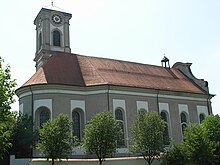|
François de Cuvilliés the Younger François de Cuvilliés the Younger (24 October 1731 – 10 January 1777) was a German architect, engraver, draftsman, engineer, and author.[1] He was the son of François de Cuvilliés (the Elder). BiographyHe was born in Munich on 24 October 1731.[1] Cuvilliés the Younger was trained by his father and later studied at the Académie royale d'architecture in Paris. In 1757 he got a job at the electoral court in Munich, around 1765 he was promoted to Captain of Engineers.[2] He was in the service of his father until, after his death in 1768, he became second chief master builder behind Karl Albert von Lespilliez. His works lead from late Rococo to early Classicism, following the October 1770 mandate of Maximilian III Joseph, Elector of Bavaria, whereby he practically forbade Rococo as a "ridiculous" ornament for country churches and called for a "noble simplicity".[3] Cuvilliés the Younger continued to publish ornamental prints based on the works of his father.[4] His incomplete textbook Vitruve bavarois, named after a textbook by the Roman architect Vitruvius, was a model for various artists of different disciplines. Works
Gallery
Further reading
References
External links
|







